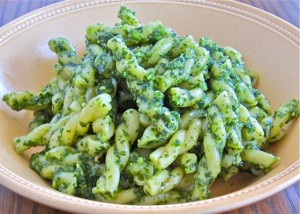5-Minute Basil Pesto

Got 5 minutes? You can be eating pasta with fresh and flavorful basil pesto, pesto alla Genovese, in no time.
This pesto hails from Liguria on the northern Italian coast where small leaf basil grows on the hills around Genoa overlooking the Italian Riviera. The roots of North Beach’s Liguria Bakery, famous for it’s foccacia, are in this region of Italy.
I don’t have Ligurian basil so I’m using organic Bay Area basil instead. You can use your local basil as well. Traditionally the pesto is made with a mortar and pestle but I’m using a food processor. It’s fast and yields a fine paste.
The main ingredients are basil, pine nuts (pinoli), garlic, grated parmigiano and pecorino, and a really good extra virgin olive oil. Use the best ingredients you can afford.
Pine nuts from China are prevalent in the market and cheaper but they taste waxy and don’t have the full, clean, nutty flavor of Italian pine nuts so buy Italian pinoli if you can.
The Ligurian version is usually made with trenette, a flat long pasta or trofie, a short twisted pasta. I used gemelli (twins) a short twisted pasta pretty close to the hard to find trofie.
This is an uncooked sauce. Just process all the ingredients in a food processor. The pesto will be ready way before the pasta water comes to a boil.
The short twisted toothy gemelli burst with fresh flavor. The aromatic basil immediately tingles your tongue followed by the nutty flavor of the pinoli and buttery olive oil. The parmigiano, pecorino and just an echo of fresh garlic round out each bite. So simple and so delicious.
A few years ago we got lucky on a visit to Rome. My friend Guiliano who lives in the historical center had just returned from visiting his family in Genoa and he invited us over for dinner. He brought just-picked Ligurian basil back with him and he was making pesto for us. He added cubes of potato and green beans to the pasta and coated it all with the best pesto I’ve ever eaten.
For my American friends adding potato and green beans to this dish is controversial. I like it that way but many don’t. They just want pasta coated with basil pesto. Try it both ways and see which you prefer.
If you want to make the traditional Genovese version, cut the potato in 1/2 chunks. Cut off the stem end of the green beans and cut them into 2-inch pieces. When the pasta water comes to a boil add the potatoes and cook for 5 minutes then add the green beans and cook for another 5 minutes. Then add the pasta and cook to al dente. Strain the pasta, potatoes and beans out of the water, put them all in a bowl, add the pesto and mix to coat everything well.
Basil pesto is the most famous but there are many, many more. Try my Pesto Trapanese from Sicily with cherry tomatoes and almonds for a different taste treat. It’s one of 3 sauces I made for my potato gnocchi.
Buon appetito!
- 1 pound (500 grams) gemelli or your favorite short cut pasta
- 3 cups fresh basil leaves, tightly packed
- 2 garlic cloves, peeled
- ½ tablespoon sea salt plus 3 tablespoons for the pasta water
- ⅓ cup extra-virgin olive oil, plus more to cover the pesto
- ¼ cup pine nuts, lightly toasted
- 2 tablespoons grated Parmigianno-Reggiano
- 2 tablespoons grated Pecorino Romano
- Put 5 quarts of water with 3 tablespoons of sea salt over high heat and bring it to a boil.
- In the meantime, put the basil, garlic, salt, and olive oil in the food-processor bowl. Process 10 to 15 seconds, stopping once to scrape down the sides of the bowl, to form a coarse paste.
- Put the pine nuts in the food processor and process another 10 seconds, scrape down the bowl midway, until you create a uniform, smooth bright-green paste.
- Add the grated cheeses to the bowl and pulse a few times to combine.
- The pesto should be thick but flowing. If it is to stiff add a bit more olive oil.
- The pesto will be fine at room temperature until you cook the pasta. (If you keep it out longer, cover the top of the pesto with a thin layer of extra virgin olive oil so it doesn’t discolor.)
- Cook the pasta to al dente, strain and put into a bowl. (Reserve some of the pasta cooking water.)
- Add the pesto and mix to coat the pasta well. If the pasta is too dry add some of the pasta cooking water.
- Top each serving with a light drizzle of olive oil and a sprinkle of grated cheese.
- Serve immediately.
- (To store the pesto longer, cover the surface of the pesto with plastic wrap, close the container tightly and refrigerate or freeze the pesto. Let the stored pesto come back to room temperature before using.)